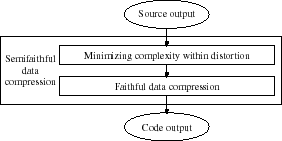Data Compression Theory
Abstract
Data compression technology is necessary in today's multimedia society.
Using this technology, information can be transmitted in a shorter
amount of time and the storage space can be made smaller.
Since data compression in broad terms means ``expressing things concisely,''
it is applied to many fields, such as
learning and inference, and so on.
We are researching theoretical studies
on limits and algorithms for data compression systems.
Our main results are as follows.
The complexity-distortion theory and the semifaithful data compression algorithm
It is impossible to transmit continuous information,
such as sound and images, faithfully on digital communication systems.
Semifaithful data compression is a practical solution to this problem,
where we permit distortion between
the original data and the reproduced data.
Since many faithful data compression
algorithms are available,
we study the problem of whether these algorithms
are applicable to semifaithful ones.
We first focus on the common properties of optimal
faithful data compression algorithms
to define the notion of the complexity.
Next, we define the notion of the complexity at a distortion level
and prove a basic theorem on its property
[1,3].
The construction of our semifaithful
data compression algorithm involves the following two steps:
firstly, a string is chosen within
a fixed distortion to minimize the complexity,
and secondly, the distorted string
is compressed by a faithful data compression algorithm
(Fig.1).
So far, we have needed specific complexities and faithful data compression
algorithms to achieve the minimum coding rate.
Our theory guarantees that we can use any complexity
and faithful data compression algorithm to construct
our semifaithful data compression algorithm with the minimum coding rate
(Table 1).
Data compression with common side information
We consider the coding problems of a source when the encoder and
the decoder have access to a common source
which is correlated with the target source.
This framework is called `data compression with common side information.'
The asymptotically optimal coding rate has been known,
but not a concrete algorithm.
We construct a concrete algorithm for faithful data compression
with common side information,
and then we apply the complexity-distortion theory
to construct a semifaithful data compression algorithm
[2,3].
[1]
Muramatsu, J. and Kanaya, F.:
Distortion-complexity and rate-distortion function,
IEICE Transactions on Fundamentals of Electronics, Communications and Computer Sciences, Vol.E77-A, No.8, pp. 1224-1229 (1994).
[2]
Muramatsu, J. and Kanaya, F.:
Universal data compression with common side information,
Proc. of the 1997 IEEE International Symposium
on Information Theory, p. 183 (1997).
[3]
Muramatsu, J.:
Universal data compression algorithms for stationary ergodic sources
based on the complexity of sequences,
Ph.D.thesis, Nagoya University (1998).
Copyright(C) 1998 Nippon Telegraph and Telephone Corporation
Last modified on
1/Nov/98

